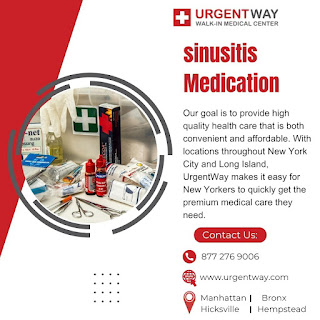Are there any exercises or breathing techniques that can help cure chronic sinusitis?
Are there any exercises or breathing techniques that can help cure chronic sinusitis?
A persistent
inflammation of the sinuses that affects millions of people worldwide is called
chronic sinusitis. The symptoms, which can seriously lower quality of life,
include nasal congestion, pressure, and pain in the face, as well as a decrease
in sense of smell. Even though doctors frequently prescribe medications like
antibiotics, nasal corticosteroids, and surgery to manage symptoms, many people
look for non-medical ways to relieve their discomfort. The application of
breathing exercises is one such substitute. This article looks at a variety of
breathing exercises and methods that can help control and in certain situations
even treat chronic sinusitis.
Understanding
Chronic Sinusitis:
Understanding the symptoms and causes of chronic sinusitis is crucial before
beginning the workouts and breathing exercises. The term "chronic
sinusitis," also referred to as "chronic rhinosinusitis,"
describes sinus inflammation that persists for more than 12 weeks in spite of
therapy. Numerous conditions, such as infections, allergies, nasal polyps, and
a deviated septum, can cause it. Chronic inflammation causes mucus
accumulation, bacterial or fungal infections, and blocked nose passages.
Exercise and Breathing Techniques: Their Significance:
By increasing sinus drainage, lowering inflammation, and enhancing overall
respiratory health, exercise and breathing exercises can be very helpful in the
management of chronic sinusitis. These techniques can help those looking for
non-pharmacological solutions or serve as a supplement to medical therapy.
Strategies for
Breathing in Chronic Sinusitis:
Breathing exercises are intended to enhance respiratory system performance,
increase oxygen flow, and lessen nasal congestion. The following are some
efficient breathing methods for persistent sinusitis:
1. The Buteyko Method of Inhaling:
Dr. Konstantin Buteyko created the Buteyko Breathing Method, which is a
well-liked method for treating respiratory disorders. The goal of this
technique is to promote nasal breathing and lessen hyperventilation through
breathing exercises. Learning to breathe through their noses can help those
with chronic sinusitis by relieving congestion and enhancing sinus discharge.
How to Do
Buteyko Breathing Exercises:
nullTake a seat comfortably and unwind:
·
Shut your mouth and inhale via your nose.
·
Breathe in small breaths and out, paying
attention to your calm, steady breathing.
·
After you've released your breath, count the
number of seconds you can hold it comfortably before you have to take another
breath.
·
Repeat the exercise multiple times,
progressively increasing the breath-holding period.
·
People who regularly use the Buteyko Breathing
Method can improve sinus outflow and lessen nasal congestion, which will
alleviate symptoms of chronic sinusitis.
2. Differential
Nastril Inhalation (Nadi Shodhana)
Nadi Shodhana, also known as Alternate Nostril Breathing, is a yoga breathing
practice that enhances respiratory function and balances the body's energy. By
inhaling through both nostrils alternately, this practice helps unclog nasal
passages and lessen inflammation.
How to Breathe Through Your Other Nostrils:
·
Maintain a straight spine and relaxed shoulders
when sitting comfortably.
·
Close your right nostril with your thumb.
·
Take a deep breath through your left nose.
·
Using your right ring finger, shut your left
nostril and open your right.
·
Breathe out slowly using your right nostril.
·
Take a deep breath through your right nose.
·
Shut the left nostril and open the right one.
·
Breathe out slowly using your left nostril.
For better
sinus health and to help eliminate nasal congestion, repeat this cycle every
five to ten minutes. People with chronic sinusitis can benefit from alternate
nostril breathing, which encourages relaxation, lowers tension, and improves
overall respiratory function.
3. Breathing Diaphragmatically
Deep belly breathing, or diaphragmatic breathing, is a type of breathing in
which the diaphragm is completely engaged. This method can lessen the symptoms
of sinusitis by improving oxygen exchange, expanding lung capacity, and
lowering tension.
Guidelines for Diaphragmatic Breathing Practice:
Place your hands on your belly and take a comfortable posture to lie down or
sit in.
Breathe deeply through your nose, feeling your abdomen rise as air fills your
lungs.
Breathe out slowly through your lips, allowing your belly to drop.
Make sure your chest stays relatively still while you concentrate on taking
calm, deep breaths.
Activities for
Prolonged Sinusitis:
Certain activities can aid in the management of chronic sinusitis in addition
to breathing techniques by enhancing circulation, encouraging drainage, and
lowering inflammation. For those with persistent sinusitis, try these
beneficial exercises:
Sinus Infection Doctor At UrgentWay Walk-In Clinic:
Sinus infectiontreatment is available at all UrgentWay locations. We are open seven days a
week from morning to evening, giving you the freedom to visit us whenever it is
convenient.
Our experienced
providers will assess your condition, advise the best sinus infection treatment
accordingly and counsel you on preventative care.
Conclusion:
A person's quality of life can be greatly impacted by chronic sinusitis, but
daily routines that include exercises and breathing exercises can help relieve
symptoms and even improve sinus health. Breathing exercises that improve
respiratory function and lessen congestion include the Buteyko Breathing
Method, Alternate Nostril Breathing, and Diaphragmatic Breathing. Additionally,
you can improve general wellbeing and stimulate circulation, reduce
inflammation, and reduce stress by engaging in activities like yoga, aerobics,
head and neck exercises, and facial massages.


.png)
Comments
Post a Comment